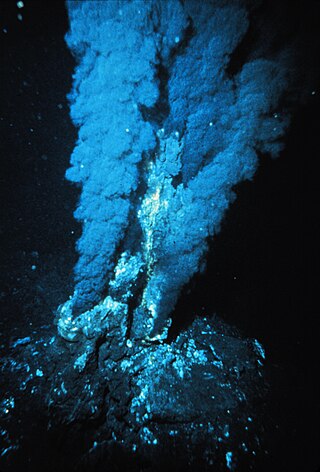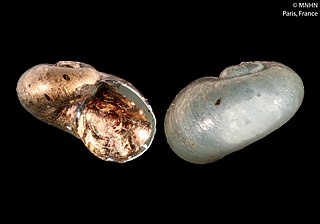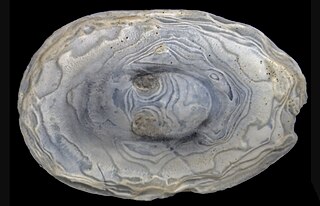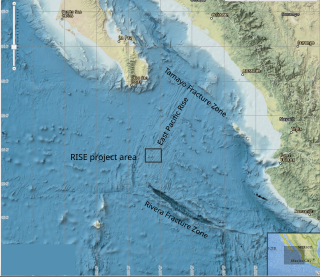Related Research Articles

Hydrothermal vents are fissures on the seabed from which geothermally heated water discharges. They are commonly found near volcanically active places, areas where tectonic plates are moving apart at mid-ocean ridges, ocean basins, and hotspots. The dispersal of hydrothermal fluids throughout the global ocean at active vent sites creates hydrothermal plumes. Hydrothermal deposits are rocks and mineral ore deposits formed by the action of hydrothermal vents.

Riftia pachyptila, commonly known as the giant tube worm and less commonly known as the giant beardworm, is a marine invertebrate in the phylum Annelida related to tube worms commonly found in the intertidal and pelagic zones. R. pachyptila lives on the floor of the Pacific Ocean near hydrothermal vents. The vents provide a natural ambient temperature in their environment ranging from 2 to 30 °C, and this organism can tolerate extremely high hydrogen sulfide levels. These worms can reach a length of 3 m, and their tubular bodies have a diameter of 4 cm (1.6 in).

Neomphalidae is a family of sea snails or limpets, specifically deep sea hydrothermal vent limpets. This family was included in the Vetigastropoda, which is a clade according to the Bouchet & Rocroi, 2005. It is now included in the clade Neomphalina.

Neomphaloidea is a superfamily of deep-sea snails or limpets, marine gastropod mollusks. Neomphaloidea is the only superfamily in the order Neomphalida.

Neolepetopsidae is a family of small deep sea sea snails or true limpets, marine gastropod mollusks in the subclass Patellogastropoda.

Lepetodrilidae is a family of small, deep-sea sea snails, hydrothermal vent limpets, marine gastropod molluscs in the clade Vetigastropoda.
James Hamilton McLean was an American malacologist. He specialized in marine gastropods. He worked on many families of Eastern Pacific gastropods including the Fissurellidae, Trochidae, Turbinidae and Liotiidae, and also investigated deep sea gastropods from hydrothermal vents.
Pyropelta corymba is a species of small sea snail, a deep-water limpet, a marine gastropod mollusk in the family Pyropeltidae
Pyropelta musaica is a species of small sea snail, a deep-water limpet, a marine gastropod mollusks in the family Pyropeltidae.

Pyropelta is a genus of small sea snails, deep-water limpets, marine gastropod molluscs in the family Pyropeltidae.
Eulepetopsis vitrea is a species of sea snail, a true limpet, a marine gastropod mollusk in the family Neolepetopsidae, one of the families of true limpets.
Lepetodrilus galriftensis is a species of small, deep-sea sea snail, a hydrothermal vent limpet, a marine gastropod mollusc in the family Lepetodrilidae.

Lepetodrilus ovalis is a species of small, deep-sea sea snail, a hydrothermal vent limpet, a marine gastropod mollusc in the family Lepetodrilidae.
Lepetodrilus pustulosus is a species of small, deep-sea sea snail, a hydrothermal vent limpet, a marine gastropod mollusc in the family Lepetodrilidae.

Lepetodrilus is a genus of small, deep-sea sea snails, hydrothermal vent limpets, marine gastropod molluscs in the family Lepetodrilidae.

Bathymodiolus thermophilus is a species of large, deep water mussel, a marine bivalve mollusc in the family Mytilidae, the true mussels. The species was discovered at abyssal depths when submersible vehicles such as DSV Alvin began exploring the deep ocean. It occurs on the sea bed, often in great numbers, close to hydrothermal vents where hot, sulphur-rich water wells up through the floor of the Pacific Ocean.
Calyptogena magnifica is a species of giant white clam found clustered around hydrothermal vents at abyssal depths in the Pacific Ocean.
Ocean Networks Canada is a world-leading research and ocean observing facility hosted and owned by the University of Victoria, and managed by the not-for profit ONC Society. ONC operates unparalleled observatories in the deep ocean and coastal waters of Canada’s three coasts–the Arctic, the Pacific and the Atlantic–gathering biological, chemical, geological and physical data to drive solutions for science, industry and society. ONC operates the NEPTUNE and VENUS cabled ocean observatories in the northeast Pacific Ocean and the Salish Sea. Additionally, Ocean Networks Canada operates smaller community-based observatories offshore from Cambridge Bay, Nunavut., Campbell River, Kitamaat Village and Digby Island. These observatories collect data on physical, chemical, biological, and geological aspects of the ocean over long time periods. As with other ocean observatories such as ESONET, Ocean Observatories Initiative, MACHO and DONET, scientific instruments connected to Ocean Networks Canada are operated remotely and provide continuous streams of freely available data to researchers and the public. Over 200 gigabytes of data are collected every day.

The RISE Project (Rivera Submersible Experiments) was a 1979 international marine research project which mapped and investigated seafloor spreading in the Pacific Ocean, at the crest of the East Pacific Rise (EPR) at 21° north latitude. Using a deep sea submersible (ALVIN) to search for hydrothermal activity at depths around 2600 meters, the project discovered a series of vents emitting dark mineral particles at extremely high temperatures which gave rise to the popular name, "black smokers". Biologic communities found at 21° N vents, based on chemosynthesis and similar to those found at the Galapagos spreading center, established that these communities are not unique. Discovery of a deep-sea ecosystem not based on sunlight spurred theories of the origin of life on Earth.
Pyrolycus is a genus of marine ray-finned fishes belonging to the subfamily Lycodinae, the eelpouts, within the family Zoarcidae. The genus was first described in 2002 by Japanese ichthyologists Yoshihiko Machida and Jun Hashimoto. The type species is P. manusanus, which was discovered in the Manus Basin off Papua New Guinea.
References
- ↑ Neomphalus fretterae McLean, 1981 . Retrieved through: World Register of Marine Species on 11 April 2010.
- ↑ Batten, Roger Lyman: Shell structure of the Galapagos Rift limpet Neomphalus fretterae McLean 1981, with notes on muscle scars and insertions. American Museum Novitates ; no. 2776 http://digitallibrary.amnh.org/handle/2246/5253 American Museum Novitates; no. 2776, New York, N.Y. : American Museum of Natural History, 1984
- ↑ Animal life in the shallow subseafloor crust at deep-sea hydrothermal vents. Open access.
- ↑ Bright, M., Gollner, S., de Oliveira, A.L. et al. Animal life in the shallow subseafloor crust at deep-sea hydrothermal vents. Nat Commun 15, 8466 (2024). https://doi.org/10.1038/s41467-024-52631-9